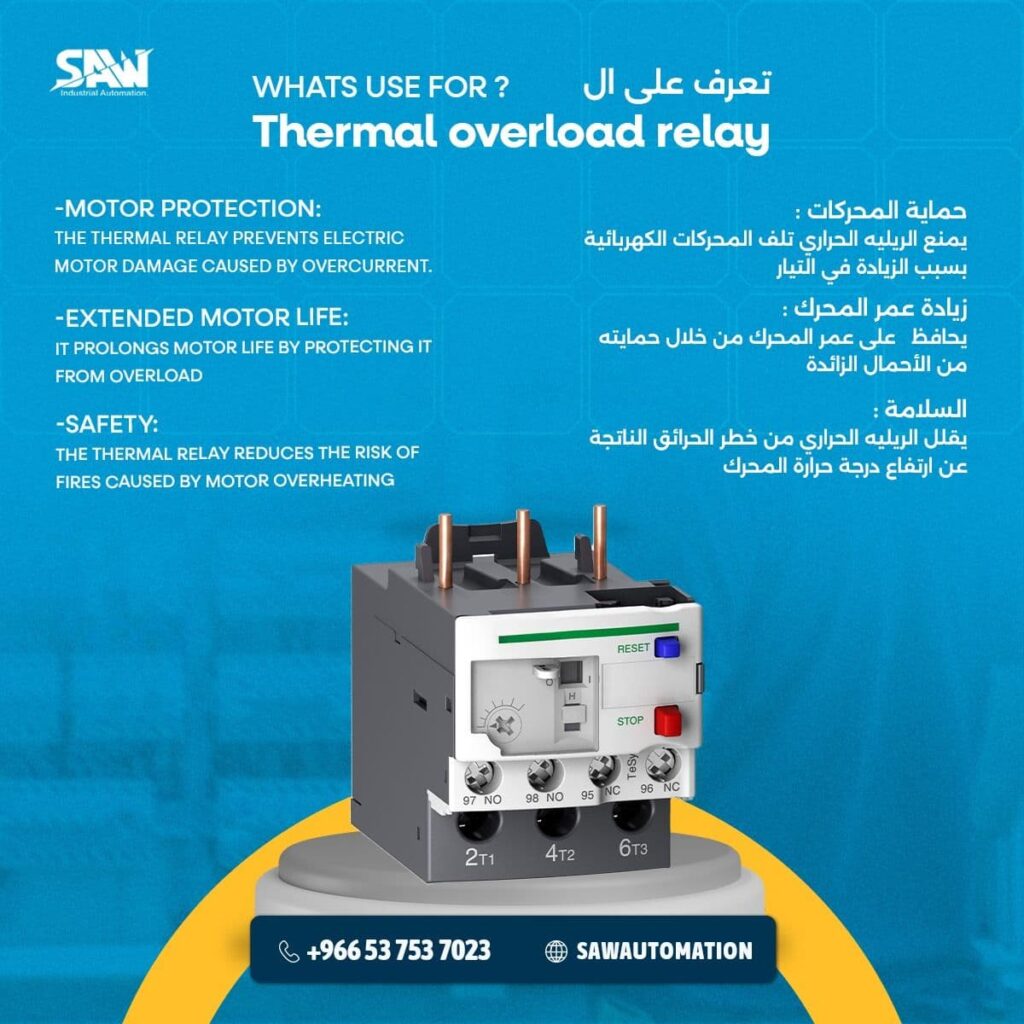What is a Thermal Relay?

What is a thermal relay?
Saw automation & electrical parts
The thermal relay is one of the important elements in commercial and industrial electrical system applications to provide necessary protection against the risks of excessive electrical currents and high loads.
In today’s article, we will discuss thermal relays, their main function, understand their working principle, talk about their different types, and highlight their main advantages and disadvantages.
What is a thermal relay?
A thermal relay is a device used to activate protection for electrical systems against the risks of receiving elevated electrical currents, which helps protect devices and equipment from damage.
When the relay detects a noticeable increase in temperature, it disconnects the electrical circuit to avoid potential risks from excess current and the occurrence of damage or malfunctions.
The relay consists of several different components, each of which plays a tangible role in the processes of being affected by electrical current and working to disconnect excess electrical current when needed.
The most important components of the relay are as follows:
• Bimetallic strips, whose main task is to detect abnormal temperature rises resulting from current.
• Electrical conductors that work to deliver electrical current to the relay.
• The disconnection mechanism responsible for disconnecting when needed.
• Visual indicators that play an important role in clarifying the reason for disconnecting the electrical current – whether the disconnection is due to a malfunction or a rise in temperature.
• Manual or automatic current adjustment settings responsible for the process of adjusting the electrical current.
How the thermal relay works
The thermal relay is an important device for achieving safety and maintaining the integrity of devices in case of excessively high temperatures by disconnecting the electrical current connected to them.
As for how the thermal relay works, it relies on a disc made of a material with a positive temperature coefficient (PTC), which has a relatively low resistance when not connected to electricity.
As soon as the compressor is connected to the electrical current, the resistance is likely to increase significantly and noticeably, and the relay temperature rises as a result of the disc heating up due to the current strength.
As a result, the current will no longer reach the start windings, while the run windings remain operational, meaning the start windings are disconnected from the circuit as the compressor starts and the relay temperature rises.
As the compressor continues to operate, the relay is expected to remain in a heated state, and its temperature will not decrease until about 30 seconds after the power is disconnected, at which point it will begin to cool gradually.
In summary, the principle of operation of the thermal relay is to disconnect the start windings from the circuit through a PTC disc to provide the necessary protection for devices during compressor operation.
What is the function of a thermal relay?
As for the function of the thermal relay, there are many different functions related to residential, commercial, or industrial electrical systems. Among its most prominent functions are the following:
• Providing necessary protection for household appliances from the risks of overloads, often used in air conditioners or washing machines.
• Protecting electric motors in industrial systems from potential risks resulting from overloads by disconnecting the electrical circuit when a current increase is detected.
• Integration into commercial electrical circuits to maintain the efficiency of the electrical system and reduce the risks of overloads.
• Providing protection for equipment and machinery in factories and workshops from the danger of overloads that may threaten to damage devices and stop them from working.
If the thermal relay disconnects the electrical current, the main reason for this must be identified before restarting to avoid repeating the situation or causing damage to devices and equipment.
Temperature may rise and the electrical circuit may be disconnected in the event of mechanical malfunctions in motors or due to voltage fluctuations, and the relay senses this increase and disconnects the current.
Different types of thermal relays
There are many types of thermal relays, each of which provides specific functions to control the operation of electrical circuits and work to achieve protection for electrical and electronic systems.
Among the types of thermal relays are the following:
Magnetic relay
This type of relay relies on magnetic coils, which play a role in opening and closing contact points when the compressor is connected to or disconnected from the electrical current.
Solid state relay
This type is characterized by fast response, as it relies on semiconductor devices such as transistors and thyristors, which perform the task of switching without the need to move any components.
Overload relay
One of the most famous types of thermal relays used in electrical and electronic devices, its great task is to protect these devices from the risks of high temperature and maintain their safety.
Protection relay
The protection relay primarily aims to ensure the smooth operation of the electrical system by monitoring the occurrence of faults, and in the event of a possibility of them, preventive measures and procedures are taken.
Latching relay
The task of the latching relay is to rationalize energy consumption by maintaining its state, whether open or closed, regardless of the input power state, to maintain energy consumption.
Time delay relay
This type of relay is characterized by the ability to set a timing for activation or deactivation, and requires performing this task before the relay begins to respond and work when the electrical current is connected.
Advantages and disadvantages of thermal relays
Thermal relays have many different advantages and disadvantages. Among the most prominent advantages of thermal relays are the following:
• They operate according to an easy and flexible operating principle that ensures the necessary protection for connected motors.
• They can be used in various applications and uses.
• Overload relays work to protect electric motors from the risk of high temperatures, especially in single-phase or three-phase motors.
• They are characterized by ease of installation, by installing them directly on conductors or on the control panel.
• Some types are also characterized by ease of use, as they rely on automatic and manual reset in their operation.
• Their integrity can be verified by using the internal test switch, which works to detect errors.
• For better and more accurate performance, these relays work to compensate for temperatures.
• It is an economical option due to its low financial cost compared to other electronic devices.
Despite the many advantages of the relay, there are some disadvantages related to its protection work, among the most prominent of these disadvantages are the following:
• Slow operation, and may take a long time when disconnecting the electrical current.
• Effective protection against the risk of short circuits may not be available.
• Some relays may be affected in their work by surrounding environmental factors, such as high temperatures.
• There may be a disparity in the level and performance of relays due to reliance on thermal characteristics in carrying out their functional tasks.
• They do not provide optimal performance in cases of electrical circuits with high loads, despite good performance with low-resistance circuits.
• They need more time to cool down when they heat up and stop working.
In order to maintain the performance of the thermal relay for a longer period, it is recommended to perform regular periodic maintenance to verify its integrity, ensure optimal performance, and extend its lifespan.
Where any potential malfunctions or damaged parts are detected and repaired, with a cleaning cycle for internal parts and the removal of dust and dirt that may affect performance efficiency.




